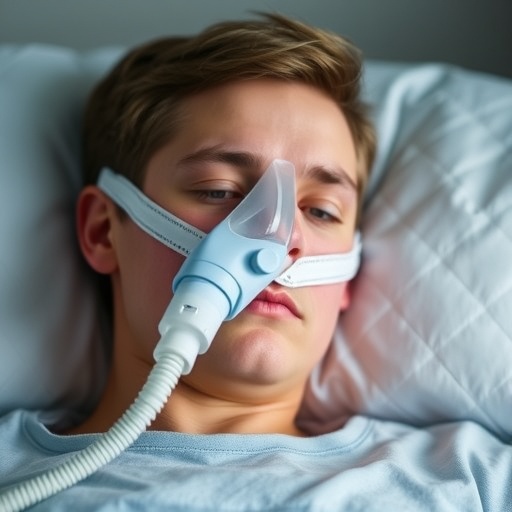In a groundbreaking study published in “Advances in Therapy,” researchers have illuminated a significant relationship between continuous positive airway pressure (CPAP) prescription and the incidence of pneumonia in patients diagnosed with obstructive sleep apnea (OSA). This retrospective database analysis, conducted by Tort, M.J., Emir, B., Nguyen, J.L., and others, sheds light on an often-overlooked aspect of managing OSA, a condition that affects millions of individuals globally. As the prevalence of sleep disorders continues to rise, understanding the implications of CPAP therapy has become crucial for healthcare providers and patients alike.
Obstructive sleep apnea is characterized by repetitive episodes of complete or partial obstruction of the upper airway during sleep, leading to disrupted sleep patterns and reduced oxygenation. Commonly associated with various comorbidities, including cardiovascular disease, diabetes, and now emerging evidence of respiratory infections, OSA presents a significant public health challenge. The rising rates of diagnosed cases necessitate the exploration of effective treatment modalities that not only address sleep disruptions but also mitigate associated health risks.
At the forefront of OSA treatment, CPAP machines have long been hailed as a standard intervention. They work by delivering a steady stream of air to keep the airway open, thereby preventing apneas. While many patients experience substantial benefits from CPAP therapy, reports of adverse outcomes have prompted researchers to delve deeper into the associated health risks, particularly pneumonia. By meticulously analyzing patient data, this research underscores the need for a nuanced understanding of CPAP therapy’s role in respiratory health.
The study leveraged a comprehensive database to examine the health records of thousands of OSA patients who were prescribed CPAP therapy. Through rigorous statistical analysis, the researchers aimed to identify correlations between CPAP use and the subsequent development of pneumonia. Interestingly, initial findings suggest a complex relationship that may reveal new insights into the management of OSA and the care of vulnerable patients who might be at heightened risk for respiratory complications.
Many healthcare professionals have welcomed the findings of this study, emphasizing the importance of patient awareness regarding the potential risks linked to CPAP usage. While the device significantly alleviates symptoms of sleep apnea and improves overall quality of life, healthcare providers are now urged to engage in nuanced discussions with patients about maintaining respiratory health. For instance, patients are encouraged to recognize the signs of respiratory infections and to seek timely medical advice, which can aid in preventing the potential onset of pneumonia.
A key aspect of the research involves understanding the mechanisms through which CPAP therapy may predispose patients to pneumonia. One theory posits that the change in airflow dynamics can lead to alterations in the upper respiratory tract environment. These changes may potentially reduce local immunity, rendering patients more susceptible to infections. Additionally, improper use or maintenance of CPAP equipment might contribute to increased risk factors, stressing the need for thorough patient education on hygiene and device maintenance.
Advocates of sleep health emphasize that the findings of Tort et al. should not discredit the efficacy of CPAP therapy but rather highlight the nuances required in OSA management. By recognizing pneumonia as a potential complication, healthcare providers can prioritize preventative strategies and tailor interventions to minimize risks while maximizing therapeutic benefits. Such an approach fosters a balanced perspective on CPAP usage, directly addressing the concerns raised by patients and empowering them through education.
As OSA management continues to evolve, researchers are encouraged to embark on further studies to unravel the intricacies of CPAP therapy’s impact on respiratory health. Researchers emphasize the importance of conducting longitudinal studies to track the long-term effects of CPAP therapy and its association with various respiratory outcomes. Such investigations could provide valuable insights into identifying patient populations that may need additional monitoring or alternative therapeutic strategies.
Additionally, the broader implications of this research extend to policy-making and healthcare practices. Insights from this study could inform clinical guidelines and protocols for employing CPAP therapy in OSA patients, ensuring that the benefits are maximized while minimizing potential adverse effects. With the increasing burden of OSA on public health systems, such research findings could prove instrumental in shaping future treatment standards and ensuring optimal patient care.
In summary, the recent findings highlight an essential dialogue between patients and healthcare providers concerning CPAP therapy and its potential implications for respiratory health. By fostering an environment of education, awareness, and proactive management, healthcare systems can navigate the complexities of OSA treatment more effectively. While CPAP remains a cornerstone of therapy, addressing the potential risks, such as pneumonia, ensures a holistic approach to patient care.
The growing interest in the relationship between CPAP use and respiratory outcomes serves as a clarion call for increased research into the long-term effects of sleep apnea management strategies. As the scientific community continues to unravel the complexities of sleep disorders and their treatments, the focus must remain on patient-centric approaches that prioritize safety and well-being. With ongoing discussions and studies, the hope is to enhance the understanding of sleep apnea and pave the way for safer, more effective treatment protocols that usher in an era of comprehensive sleep health management.
In conclusion, as more evidence surfaces regarding the interplay between CPAP therapy and pneumonia, this research marks a pivotal moment in the medical landscape of obstructive sleep apnea. A concerted effort to scrutinize the nuances of treatment will ultimately lead to improved patient outcomes, redefining how healthcare professionals view and approach CPAP therapy in the context of broader respiratory health issues.
Through continuous examination of research and clinical practice, the dialogue surrounding obstructive sleep apnea, CPAP therapy, and associated risks like pneumonia will continue to evolve. By prioritizing awareness and education, healthcare providers can empower patients to make informed decisions about their health, ultimately leading to enhanced management of obstructive sleep apnea and improved quality of life for those affected by this condition.
Subject of Research: The association between CPAP prescription and pneumonia among patients with obstructive sleep apnea in the United States.
Article Title: Association of CPAP Prescription and Pneumonia Among Patients with Obstructive Sleep Apnea in the United States: A Retrospective Database Analysis.
Article References:
Tort, M.J., Emir, B., Nguyen, J.L. et al. Association of CPAP Prescription and Pneumonia Among Patients with Obstructive Sleep Apnea in the United States: A Retrospective Database Analysis.
Adv Ther (2025). https://doi.org/10.1007/s12325-025-03343-z
Image Credits: AI Generated
DOI:
Keywords: OSA, CPAP therapy, pneumonia, respiratory health, sleep disorders, healthcare, patient care
Tags: comorbidities associated with sleep apneacontinuous positive airway pressure effectivenessCPAP therapy benefitshealthcare provider guidelines for OSAimproving patient outcomes with CPAPobstructive sleep apnea managementpneumonia risk reduction in OSApublic health challenges in OSArespiratory infection preventionretrospective database analysis in healthcaresleep apnea prevalence and treatment strategiessleep disorder treatment implications






